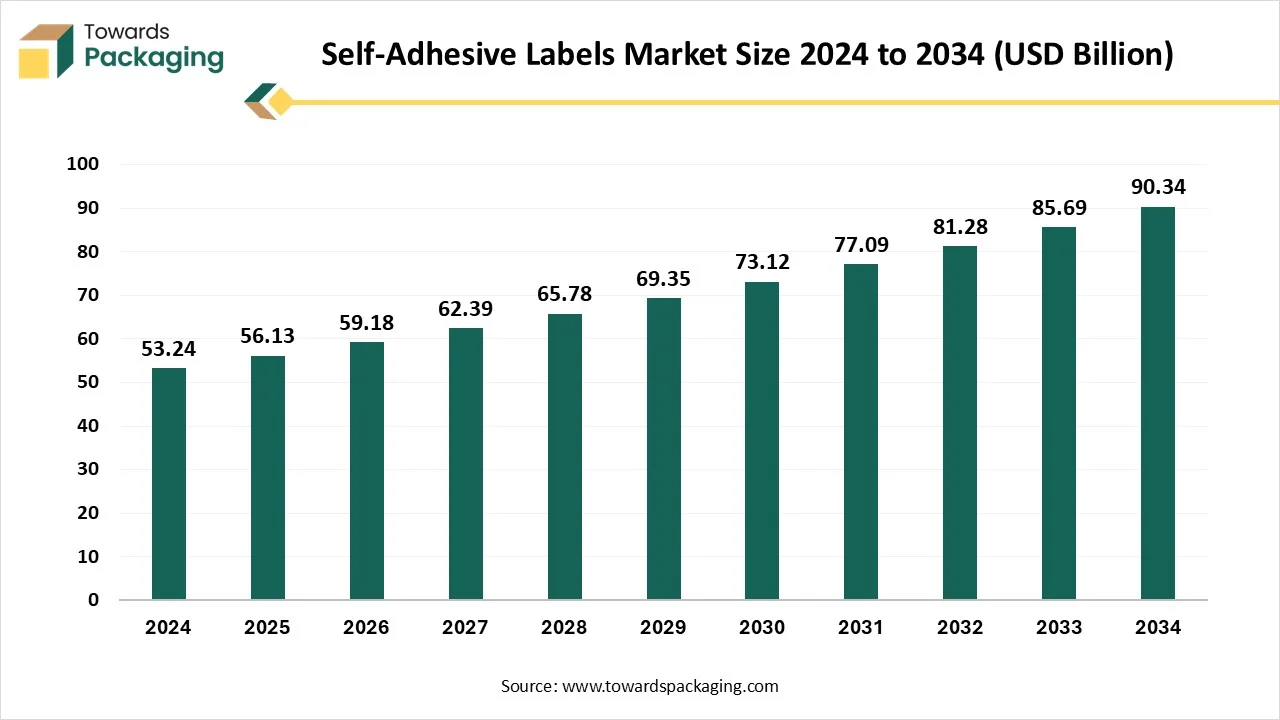The self-adhesive labels market is on a strong growth trajectory, expected to rise from USD 56.13 billion in 2025 to USD 90.34 billion by 2034, registering a CAGR of 5.43% during the forecast period. This surge is fueled by advancements in labeling technologies, rising e-commerce demand, and increasing adoption of eco-friendly materials.

Let’s explore what’s driving this market, the key trends, and how innovations like AI and smart labeling are shaping its future.
Market Overview: Why Self-Adhesive Labels Are in Demand
Self-adhesive labels are pre-applied adhesive labels that stick to surfaces without requiring water, heat, or solvents. They are used widely across industries such as packaging, logistics, healthcare, retail, and manufacturing because of their ease of use, versatility, and cost-effectiveness.
These labels consist of:
-
Face material: Paper, plastic, or other substrates for printing.
-
Adhesive layer: Ensures strong bonding to surfaces.
-
Release liner: Protects the adhesive until use.
Invest in Our Premium Strategic Solution: https://www.towardspackaging.com/download-databook/5537
Key Insights from 2025 Market Data
-
Regional Insights
-
North America led the global market in 2024.
-
Asia Pacific is projected to witness the fastest growth during 2025-2034.
-
-
Segment Insights
-
Adhesive segment held the largest share in 2024.
-
Release liners dominated by type segment.
-
Flexography printing technology is forecast to grow significantly.
-
Growth Drivers Powering the Market
Rising Regulatory and Consumer Demands
With stricter labeling regulations and consumer expectations for detailed product information, industries are turning to self-adhesive solutions for durability and visibility.
Personalized and Eco-Friendly Labels
Advances in digital printing enable brands to create custom, eye-catching labels, while the shift toward sustainable materials meets the demand for eco-conscious products.
Boom in E-commerce and Logistics
As online shopping grows, so does the need for efficient labeling for shipping and tracking.
Get All the Details in Our Solutions – Access Report Preview: https://www.towardspackaging.com/download-sample/5537
Future Trends to Watch
Eco-Friendly Innovations
Companies are developing recyclable and biodegradable adhesives and facestocks to minimize environmental impact.
Smart Labels on the Rise
Integration of QR codes, RFID, and NFC technologies is creating interactive labels that improve tracking, authentication, and customer engagement.
Advanced Materials and Technologies
New materials like multi-layered adhesives and linerless labels are improving efficiency and reducing waste.
How AI is Transforming the Self-Adhesive Labels Industry
Artificial Intelligence is playing a pivotal role in reshaping this market by enabling:
-
Smart design creation with AI tools analyzing trends and customer preferences.
-
Quality control using AI-powered vision systems to detect defects in real time.
-
Predictive maintenance of production lines to minimize downtime.
-
Inventory management optimization through AI algorithms forecasting material needs.
AI is also enhancing customer experience with 3D label previews and simulated testing of label designs.
Recent Industry Advancements (2025 Updates)
-
Elkem ASA introduced its SILCOLEASE RE range, made from chemically recycled materials for sustainable label solutions.
-
Trinseo launched A9615 adhesive for film labels, enhancing durability.
-
Fedrigoni revealed its Wet-Glue collection using high-barrier recycled fibers.
-
Bostik released Fast Glue Ultra+, with 60% bio-based content for greener adhesives.
-
Lecta debuted linerless thermal facestock for waste reduction.
Challenges for the Market
While the market is thriving, it faces hurdles like:
-
Competition from alternative labeling solutions (e.g., shrink sleeves, in-mold labeling).
-
Adhesion issues on rough, oily, or extreme surfaces.
-
Global economic instability affecting supply chains and raw material costs.
If you have any questions, please feel free to contact us at sales@towardspackaging.com
Opportunities Ahead
Smart Labeling Integration
With growing demand for RFID and IoT-connected labels, there’s huge potential for companies to offer innovative, interactive solutions that improve tracking and consumer engagement.
FAQs About the Self-Adhesive Labels Market
Q1: What is the projected market size of self-adhesive labels by 2034?
The market is forecast to reach USD 90.34 billion by 2034, growing at a CAGR of 5.43% from 2025.
Q2: Which region dominates the self-adhesive labels market?
North America led the market in 2024, but Asia Pacific is expected to grow at the fastest rate during 2025-2034.
Q3: What are the major trends driving this market?
Key trends include the shift to eco-friendly materials, the rise of smart labels with RFID and QR codes, and increasing demand from e-commerce and logistics.
Q4: How is AI impacting the self-adhesive labels industry?
AI enhances label design, improves quality control, predicts maintenance needs, and optimizes inventory, making the production process smarter and more efficient.
Q5: What challenges could limit market growth?
Challenges include competition from alternative labeling methods, adhesion issues on difficult surfaces, and economic fluctuations affecting supply chains.
Source : https://www.towardspackaging.com/insights/self-adhesive-labels-market-sizing

